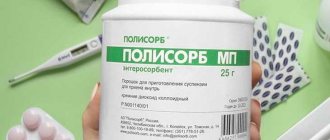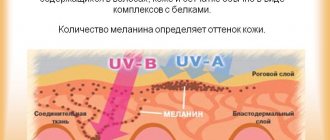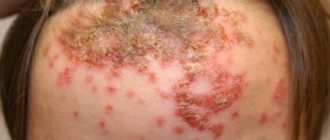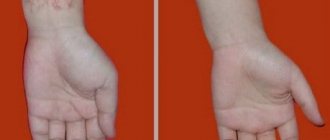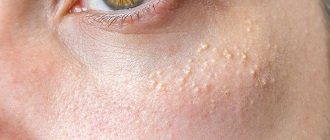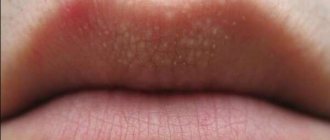Causes
According to statistics, up to 5% of all chemical burns are caused by peroxide. They most often occur when ingesting a peroxide solution or exposing the skin to liquids with a reagent concentration above 10%.
The most dangerous is perhydrol - a liquid containing up to 35% hydrogen peroxide.
A hydrogen peroxide burn can have the following causes:
- working with concentrated solutions without protective equipment (gloves, goggles) in chemical, textile and other industries,
- storing peroxide disinfectant solution in unsuitable places, for example, in direct access to a child,
- contact with a chemical when a storage container breaks,
- long-term exposure of a 6-9% solution of the product to the scalp when coloring hair,
- accidental ingestion when rinsing the mouth and gums,
- allergy to the substance.
Symptoms
Symptoms vary depending on the extent and location of the burn. The degree of damage is determined by the concentration and volume of the substance that gets on the skin or mucous membrane.
Leather
A skin burn with hydrogen peroxide is accompanied by redness (hyperemia) or discoloration of the burned areas, swelling and pain of varying intensity. At high concentrations of the substance, blisters appear on the skin, and some affected areas undergo necrosis . When severe injuries heal, scars form on the skin.
Oral cavity
A burn of the oral cavity and pharynx is manifested by the following symptoms:
- swelling of the affected area,
- blanching of the burn area, which clearly distinguishes it from the background of healthy tissue,
- severe pain (when the reagent concentration is above 6% for the oral cavity and more than 10% for the pharynx).
In severe cases, areas of wet necrosis appear in the mouth. Under the influence of peroxide, the mucous membrane becomes loose, which promotes deeper penetration of the reagent and further expansion of the affected area. Scars after healing of the oral cavity are more massive than with damage to the skin.
Ingestion of hydrogen peroxide causes burns to the esophagus and stomach, causing swelling, stenosis of the upper gastrointestinal tract and severe pain. As a rule, burns of internal organs are combined with lesions of the skin near the lips, mucous membranes of the mouth and pharynx.
Eyes
Both concentrated hydrogen peroxide and a harmless pharmaceutical solution can burn the cornea of the eye.
Contact with 3% peroxide causes irritation of the eye mucosa, photophobia and excessive lacrimation. The patient feels a burning sensation in the cornea, and vision temporarily deteriorates.
With more severe burns, the cornea becomes cloudy, and the burning sensation turns into a full-fledged pain syndrome. The intensity of the pain increases over several hours. The affected eye swells and turns red in the conjunctival area. When exposed to perhydrols and technical peroxide solutions, ulcers and perforation areas form on the structures of the eye.
In terms of the specific action on mucous membranes, hydrogen peroxide is similar to alkalis. These substances penetrate deeply into tissues and cause severe damage. In case of a corneal burn, the prognosis for several days after the injury worsens compared to the initial one.
Antiseptic Hydrogen Peroxide – Review
Hello!
Hydrogen peroxide is a good old remedy, proven over the years, which is probably in every first aid kit.
This antiseptic is the first aid for skin damage.
Thanks to the reaction, that same effervescent cloud, all the dirt is pushed away from the wound surface and everything is safely disinfected.
It is especially popular with us in the summer, when the child keeps knocking out his knees and elbows. And so, in case of any injuries (abrasions and cuts), peroxide is always on guard.
In addition to standard use, this product has many applications, which are very extensive and even sophisticated.
Some people use it to whiten their teeth (I certainly wouldn’t risk it), some manage to lighten their hair (not only on their heads, but also on their arms, for example), others even manage to drink it. With its help, you can even make medicinal solutions for various ailments (to bury your nose, ears and gargle). There are no limits to imagination.
In everyday life, hydrogen peroxide can also be used in many ways: add to water when washing floors, whiten stains on white clothes, or get rid of an unpleasant odor.
In personal care, this miracle product can also surprise you, because with it you can achieve smooth and beautiful heels by getting rid of rough skin. All you need to do is add 30-50 ml. in a bowl of warm water and immerse your feet there for about 10 minutes. Finally, thoroughly clean your feet with a pumice stone and enjoy smooth and soft skin.
You can list many more ways, where to use it, how and why, but I would like to share another non-standard method, namely the use of peroxide for post-acne and skin pigmentation.
I learned about this a long time ago, but I didn’t practice it that often before.
For the first time, pigment spots appeared during pregnancy. This is a normal phenomenon, because it happens to almost everyone. After giving birth, they somehow went away on their own, I didn’t even try to get them out.
You know, age spots are also called age spots! At the age of 30, it’s somehow scary to hear such medical terms, according to dermatologists.
This summer I again encountered pigmentation on my face. I didn’t panic ahead of time, I thought everything would go away on its own again, but I was a little mistaken.
Against the background of a tan, the spots stood out even more, and it was very difficult to disguise them. They held up very well, even when the tan faded. That's when I decided to try peroxide.
I read a lot of positive reviews on the forums, so I decided to experiment.
before
You can make various masks with peroxide (with cottage cheese, honey, etc.), but I’m still careful about using peroxide on the entire face, because it can dry out the skin. I applied only pointwise, in places where pigment spots were localized.
before
It is worth remembering that for the skin you need to take 3%, but even then, act very carefully, because if you behave ineptly, you can cause harm and cause a burn.
before
It is important not to overuse!
2-3 times a week will be enough. I applied it neat with a cotton swab in the evenings, after washing my face. The sensation is quite comfortable, the peroxide does not pinch the skin and does not cause a burning sensation. It doesn't make the skin peel off.
After a month you definitely need to take a break.
before
Hydrogen peroxide tends to whiten the skin due to a chemical process. The top layer, which has already served its purpose, will come off safely and make way for new, renewed skin.
after
The result will not be immediate, but with the help of this product you can really noticeably lighten age spots and post-acne, even if not 100% get rid of them, but still...
With old pimple marks it may be a bit weak. In this case, badyaga is more effective.
after
To achieve the maximum whitening effect, you should turn to acid peels. Now is the best time to hold them, when the sun is not so active.
The causes of pigmentation can be different: hormonal imbalance, genetic background, age-related skin changes, squeezed pimple, etc. Cream with spf doesn't always help.
before and after
After a month of use (2-3 times a week), I noticed that age spots became less pronounced and hydrogen peroxide played a significant role in this. I think I’ll stop there for now and take a break. Peels and clay masks will be just as great helpers in the fight for clear, blemish-free skin.
Thank you for attention!
Source: https://irecommend.ru/content/kak-osvetlit-postakne-i-pigmentnye-pyatna-s-pomoshchyu-perekisi-vodoroda-massa-primenenii-i
First aid in case of defeat
Competently and timely first aid significantly improves the prognosis and shortens the healing time of skin and mucous membrane injuries. It is especially important to quickly remove the reagent from the affected area in case of burns to the eyes and internal organs .
Leather
For skin burns, the following measures are effective:
- Rinse the affected area with plenty of water. Performed no later than half an hour after injury.
- Using neutralizing agents (weak acid solutions) for rinsing after removing the reagent from the skin surface.
- Apply a sterile dry bandage to the injured area.
Treatment
Treatment of burns with hydrogen peroxide includes several stages:
- Neutralization and removal of the chemical reagent from the affected area.
- Detoxification and restoration of normal water-salt balance in the body (for internal burns).
- Symptomatic treatment.
- Rehabilitation measures that stimulate healing and restoration of damaged tissues.
Traditional
Drug therapy for hydrogen peroxide burns may include the following drugs:
- for skin lesions - Panthenol, Levomekol, Metrolavin, ointments and sprays with lidocaine,
- for eye burns - Inocaine, Alcaine, Levomycetin,
- for burn swelling of the throat - aerosol forms of novocaine with ephedrine or adrenaline, Prednisolone,
- for internal burns - a dropper with sodium bicarbonate (for acidosis), Cordiamin and Caffeine (for cardiovascular failure caused by injury), Atropine, Papaverine, Platiphylline (for burn shock), hormonal anti-inflammatory drugs (Prednisolone).
As supportive treatment, injections of B vitamins and antioxidants are used, as well as physiotherapy (electrical stimulation, magnetic therapy, franklinization, ultraphonophoresis, enzyme electrophoresis).
In case of severe lesions, tissue plastic surgery or removal of part of the organ is necessary.
Folk
It is recommended to use traditional medicine methods only at the rehabilitation stage . The following remedies are useful for restoring skin and mucous membranes after burns with peroxide:
- compresses with sea buckthorn oil and an oil solution of vitamin E (1-2 drops per 2 tablespoons of base oil),
- applications with strong black tea, infusion of coltsfoot or oak bark (2 tablespoons of plant material per 1 glass of boiling water),
- washing with infusion of birch leaves and buds (1 tablespoon per 1.5-2 cups of boiling water),
- compresses for eyelids with infusion of clover flowers (1 tablespoon of dry raw material per 200 ml of boiling water),
- rinsing with a decoction of oak bark (1-2 tablespoons per 200 ml of boiling water) or chamomile (1 tablespoon per glass of hot water).
White spots on the skin from hydrogen peroxide, what to do?
One of the most common and accessible home remedies is hydrogen peroxide, which helps cope with various skin defects.
But, despite its high effectiveness, peroxide treatment can have negative side effects.
In order to get rid of hyperpigmentation, many resort to various means and procedures, including traditional medicine recipes.
How does hydrogen peroxide work on the skin?
Lightening dark spots on the skin with hydrogen peroxide often leaves behind unpleasant consequences in the form of white areas of hypopigmentation. To find out why this happens and what to do about it, you need to familiarize yourself with the composition of this product and its effect on the human body.
Using peroxide you can get the following effect:
- whiten dark spots;
- dry the skin;
- cleanse the skin of bacteria;
- disinfect the skin;
- remove acne.
Peroxide helps make facial skin smoother and brighter, and also reduces acne marks. With its regular use, even old areas of pigmentation and scars disappear.
In cosmetology, a product such as hydrogen peroxide is often used due to the chemical reactions that occur upon contact with the skin: this substance consists of a mixture of oxygen and water, and as a result of its contact with tissue, the oxidation process is started.
Once released, oxygen actively combines with dirt, toxins and sebaceous secretions. This leads to the formation of bubbles that push harmful substances and the contents of pustules onto the surface of the dermis.
During the breakdown of the medicinal substance, water removes all toxins and elements that are on the skin.
Chemical burns or white spots may appear against the background of cell oxidation. This damage to the skin structure can cause a serious dermatological problem, so use peroxide with caution.
A standard pharmacy solution of hydrogen peroxide usually contains from 3 to 3.5% and is considered relatively safe for the skin. Therefore, the low concentration of the substance allows this product to be used by people with different skin types.
Particularly dangerous is peroxide 3.5%, which, if it comes into contact with the skin in undiluted form, can cause serious tissue damage. When diluting this substance, you must follow all safety precautions and protect exposed areas of the body and eyes from possible contact with the solution.
Precautionary measures:
- Before using peroxide, it is recommended to conduct a skin test and apply a small amount of the product to the inner crease of the elbow or the back of the hands. If your skin is too sensitive, an allergic reaction or irritation may occur. In this case, using the product is not recommended.
- In its pure form, hydrogen peroxide can be applied directly to spots, pimples or acne marks, while avoiding direct contact with surrounding tissues, especially mucous membranes and eyes.
- When using peroxide in masks, strong emollient products should be used as additional components: honey, egg yolk, olive oil, etc.
- You can increase the therapeutic effect if you first cleanse your face of cosmetics and dirt and only then use a chemical solution.
- It is allowed to use the pharmaceutical product no more than twice a week and keep it for no more than 15 minutes so as not to cause a burn.
- After rinsing, be sure to apply a moisturizing or nourishing cream to the skin.
- The treatment course for pigmentation with peroxide lasts about one month, then you need to take a mandatory break for two weeks. At this time, masks with natural ingredients will help restore the microscopic damage to the skin that has occurred.
Compliance with all recommendations and rules for using the chemical will help avoid injury to skin structures and safely get rid of cosmetic problems.
Useful recipes with peroxide
- Peroxide should be applied to dry skin using a cotton swab (or cotton swab), which is applied to the problem area.
You can remove the product with a damp cloth, and then apply a moisturizer without harmful dyes and additives to the skin. You can repeat this procedure several times a day until the spot on the skin becomes lighter. - In order to fade freckles or pigment marks on the body, it is recommended to combine peroxide with grapefruit juice in a 1:1 ratio. After this, you need to treat the skin with the prepared solution.
- Peroxide taken in the amount of 2 teaspoons and potato starch 1 tablespoon will help remove freckles. After mixing, the mask should be applied to the face and when it dries, rinse with plain water.
- In addition, you can add hydrogen peroxide to a Vaseline-based cream or ointment.
This product should be used immediately after preparation, as it quickly loses its strength. - You can also rinse your mouth and throat with peroxide by mixing one teaspoon of the solution with one glass of water. This product will have an antibacterial and disinfectant effect.
Traditional medicine offers several safe and effective ways to remove cosmetic defects using peroxide:
- Masks;
- Rubbing;
- Compresses.
Peroxide can be used topically or as a cleansing face mask. It is recommended to clean the skin with peroxide at home in combination with the following ingredients: honey, cottage cheese, aloe, yeast. Homemade masks help whiten pigmentation, normalize the functioning of the sebaceous glands and even out the complexion.
Mask with cottage cheese
In order to make a curd mask with peroxide, you need to take a tablespoon of heavy cream or cottage cheese and add 8 drops of this chemical solution to it. You can also put one egg yolk in the mask. The resulting mixture should be applied to the face in an even layer. Wash off after 15 minutes. The curd product is ideal for dry and sensitive skin.
Mask with honey
A honey mask with peroxide helps to gently cleanse the skin. To prepare the mask, you will need 2 drops of iodine, one tablespoon of honey, one spoon of aloe juice and 2 drops of peroxide. The resulting mixture can be applied only to pigmented areas or to the entire surface of the face. Wash off after 15 minutes.
Yeast mask
To make a yeast mask, you need to take two tablespoons of yeast and dilute it with peroxide until you get a thick consistency. Apply the yeast mask only to blackheads on the face or directly to the area of pigmentation. Yeast helps restore skin cells and eliminate acne.
Badyagi mask
You will need to take 5 g of badyagi and add a couple of drops of peroxide to it, then apply the finished mixture all over your face. You need to wash off the mask after 10 minutes. With the help of this product it is possible to dry out acne and relieve skin inflammation.
Prevention
In order to prevent burns, it is necessary to follow safety rules when handling hydrogen peroxide:
- it is prohibited to pour pharmaceutical and concentrated peroxide solutions into containers for drinks and food, as well as into bottles without markings indicating the substance and its concentration,
- the product must be stored in places inaccessible to mentally ill and young family members,
- Perhydrols and other saturated solutions of substances should not be kept near places for preparing and storing food,
- when contacting peroxide with a concentration above 6%, it is necessary to use protective gloves, and when constantly working with the reagent, goggles,
- immediately after use, carefully seal the container with the substance,
- It is not recommended to use traditional methods of treatment that involve ingesting an antiseptic even in minimal concentration.
Ingestion, prolonged contact with the substance and careless handling of concentrated solutions of the reagent are the most common causes of burns. By following safety rules, the likelihood of injury is reduced, and only allergy sufferers and people with hypersensitive skin (for example, with atopic dermatitis) remain at risk.
Reviews
Anna, 36 years old, Saransk. For a long time I didn’t believe the reviews on the Internet. I always had peroxide in my home medicine cabinet, but I never thought of using it for whitening. A friend persuaded me to try it for a long time, telling me how she had reduced all her freckles. Finally, I made up my mind and started using peroxide to remove a large pigment spot. At first nothing happened, but after 4-5 procedures the pigmentation turned white and gradually went away.
Svetlana, 42 years old, Nizhny Tagil. I have been using peroxide solutions and masks for a long time to whiten my skin. And recently, after an unsuccessful experiment with hair dye, I developed a terrible allergy and itching under my hair. We read about fighting allergies with hydrogen peroxide, and I thought it couldn’t get any worse. And it’s true - my head quickly stopped itching, and at the same time the dandruff disappeared.




